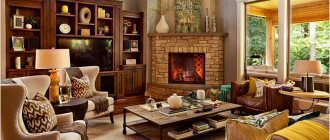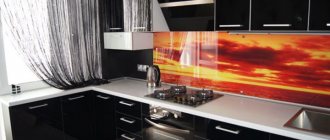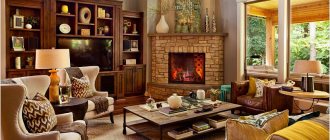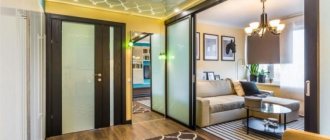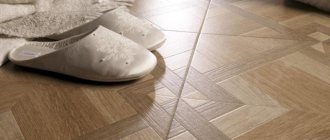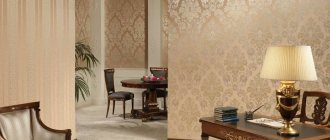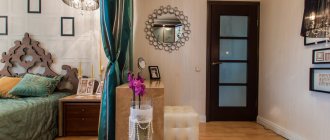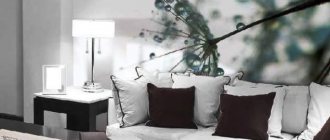Living room wall decor Dividing the bedroom into zones Wall decoration in the kitchen
This practical approach is justified, as it allows any interior to be provided with maximum functionality, and, due to the ease of implementation, does not require effort to find ways to save free space.
We will share how to zoning rooms with wallpaper using specific examples: we will talk about the possibility of color division of the living room, bedroom, kitchen and other rooms.
There are many interesting options for combining wallpaper to achieve this result: the most stylish and effective of them can be implemented not only in modern styles, but also in classic, provincial and many other interiors, so knowing the intricacies of this universal method will not hurt you.
Technique for gluing wallpaper with flowers
As a general rule, it is correct to start pasting from the window. In the case of wallpaper with flowers, it is better to start it from the wall adjacent perpendicular to the wall in which the window is located.
This is due to the fact that the pattern will inevitably shift slightly in the corner. To level out this displacement and make it invisible, a strip of wallpaper is pasted in such a way that a strip of wallpaper no more than 20-30 mm wide is wrapped at the corner.
In the corners, you should coat the wall with glue especially generously and during gluing, use a plastic wallpaper spatula, using the different rounded corners of which you should try to glue the wallpaper in the corners as tightly as possible.
Main reasons for zoning
Even if you believe that color or texture zoning of home interiors is a whim and not a necessity, you will be right. This method plays, first of all, an aesthetic role , and partitions, shelves and pieces of furniture have long been used to highlight individual zones.
But simultaneous gluing of several types of wallpaper will allow you not only to make the room more dynamic : thanks to the careful selection of shades, each zone of the home interior will maintain its own atmosphere.
The division of zones with wallpaper is carried out for several reasons:
- the different purposes of individual parts of the room require the formation of a special design: a single style is not always able to emphasize the individuality of each zone ;
- often even a small space in the bedroom, living room and other rooms requires visual division . Massive cabinets or partitions will “eat up” an already small area, and correctly selected wall shades can even provide a visual expansion of the interior;
- Providing zoning using wallpaper is also useful if you do not know how to combine furniture belonging to different styles . Most often, this is typical for the living room: highlight the reception area using aged furniture - and with the correct color delimitation of the space, such a design will not contradict the modern equipment of the rest of the room;
- Using wallpaper of different shades is useful when you want to highlight the main part of any room . Brighter or patterned wallpapers are glued to a free wall and form a bright accent that makes this part of the interior the main one;
- Zoning the interior with wallpaper is useful in rooms where several people live (for example, in a nursery). This approach allows everyone to decorate the walls in accordance with their own tastes and preferences.
Tip: to make the zoning effect more noticeable, try not to combine wallpapers of the same palette and saturation level. This approach is only permissible when one of the wallpapers contains a large, eye-catching pattern.
You will find many photos of wallpaper zoning showing how this method contributes to space correction . For example, narrow interiors decorated with several wallpapers for the walls at once in compliance with the design rules for pasting will be perceived as more proportional. Excessively spacious rooms that cause discomfort can be visually reduced in size and made more comfortable.
Ecolabel
If you are concerned about the environmental safety of the finishing materials you purchase, look for one of the following signs on the packaging:
- 1 - EcoMaterial - Russia, produced by EcoStandart based at Moscow State University;
- 2 - Leaf of Life - Russia, St. Petersburg Ecological Union;
- 3 - Northern swan - Denmark, Norway, Sweden, Finland;
- 4 - EU Flower - countries of the European Union;
- 5 - Blue Angel - Germany;
- 6 - Eco-label - Japan;
- 7 - Green sign - USA;
- 8 - Ecological choice - Canada.
Determining material requirements
The manufacturer will tell you with his markings how to determine the top of the wallpaper in a roll.
But you still need to purchase the exact amount of material, for which you will have to measure the perimeter of the room and the height of its ceiling.
Using a tape measure, we determine the necessary parameters, after which we divide the length of the walls by the width of the wallpaper, the size of which varies between fifty and one hundred centimeters.
We specify the height of the ceiling, which is equal to the length of the strip with the addition of a small overlap. Dividing the length of the entire roll by the size of the ceiling height, we determine the number of strips.
Types of wallpaper raw materials
The first people to use wallpaper on walls were in ancient China; for this they used bright canvases of painted paper. Subsequently, decorating the walls of a room with paper spread throughout the world. But wallpaper got its name in Europe.
The materials from which wallpaper is made are constantly being improved, and the construction market never ceases to delight consumers with new, original wallpaper products. Its quality differs in the following ways:
- base and top coat;
- performance properties;
- structure of the material;
- number of layers.
Combining a paper base with a coating is by far the most popular type of wallpaper. This is due to the reasonable price and ease of use; natural raw materials are also an important factor.
The absence of films like vinyl or non-woven wallpaper makes paper wallpaper a preferable option for the bedroom and nursery, thanks to its breathable surface.
Improved paper products meet all the requirements for quality standards, and a variety of bright colors and original texture options make them competitive.
Rules for combining wallpaper and textures
In such a matter as design, one cannot do without rules, and even more so when combining colors, patterns and textures. In order for wallpapering of two types to look harmonious, it is necessary to take into account a number of parameters.
Ceiling height
It is this characteristic of the room that dictates the choice of the type of pattern, and also largely determines the texture and color. If the ceiling height is less than 2.5 m, use wallpaper in light colors, without a rough texture, with a small pattern. If the ceilings are very low, a combination of a light main background with a faint texture or pattern, vertical stripes (a pattern, or just canvases of a different color) that can be located on one wall, but it is better to distribute them over two or even three, can correct the situation.
Vertical stripes “raise” the ceiling
High ceilings - from 3 m and above - require a radically different approach. Here, on the contrary, a large drawing, stretched in width, is needed. You can use horizontal wall divisions using different colors in the top and bottom halves (see more below). To make this design look modern - this is still a classic technique - you need to put a lot of effort into choosing colors and/or patterns.
Room dimensions
In addition to height and width, we pay attention to geometry. First, to the square. If the room is large, you can use more saturated or darker shades. This will visually reduce the dimensions. If plain dark walls do not please you, find dark-colored wallpaper with a light, large pattern. As a rule, these are plant motifs, abstraction or geometry are also found.
In small rooms, everything is definitely the opposite: use light colors. If it has a texture, then it is not large; the pattern is small, not very clearly expressed.
Secondly, we pay attention not to geometry. If the room is long and narrow. In this case, the situation will be saved by gluing two types of wallpaper: lighter ones are glued to short walls, and some of them “go around” the corner. This way the geometry is visually aligned.
There is also a technique that is used if the entrance to a narrow room is on one of the long sides. Then it’s worth highlighting the middle of the opposite wall with a different color, pasting the corners with the same wallpaper that is intended for short ones. The perception of the room will change significantly: it will no longer seem so long.
Selecting a texture
In general, gluing two types of wallpaper requires careful selection of the texture and thickness of the canvas. When combining, it is advisable to use the same type of panels. If the joining occurs only in the corners, then you don’t have to pay much attention to the thickness and texture: you still won’t be able to see much in such a place. But if the connection of the canvases is on a flat wall, then the difference in thickness will only emphasize the transition. It usually looks too exaggerated.
One more moment. If you decide to glue different types of canvases, you need to use the appropriate glue for them. For example, for wallpaper on a non-woven basis, you have your own - on paper - your own. The same applies to the coating - for vinyl and structured canvases there is a different type, for acrylic - another. Don't want to fool your head? Buy a universal one. There are such compositions.
Light or dark
If the room is too light, or the interior is too monotonous, it is not necessary to use dark wallpaper on all walls. You can cover the wall opposite the window dark, let the rest be light. As a result, the room will not be very bright, and you will get rid of the oppressive atmosphere that dark walls create.
This technique works the other way around: to brighten a room, just hang light-colored canvases on the wall opposite the window. It will become much lighter.
Wall covering options
Decorative wall decoration with wallpaper has several options, depending on the raw materials and the method of manufacturing the materials. The following types of coating are most often used for cladding the walls of rooms:
- Paper based wallpaper;
- Vinyl wallpapers;
- Textile wallpaper products;
- Liquid wallpaper;
- Photo wallpaper;
- Non-woven.
The disadvantages of paper-based wallpaper are that they get wet quickly, and that they easily absorb dust and quickly become dirty.
To decorate walls in the kitchen or bathroom, it is better to use vinyl wallpaper that is resistant to water and steam. Important! It is not advisable to paste residential premises with this type due to the release of formaldehyde.
It is possible to combine options for decorating walls with wallpaper by selecting an interesting pattern on wallpaper that has a different structure of materials and is made from different types of raw materials. Below is a photo of wall decoration with wallpaper.
Why do you need large size wallpaper: purpose
Large rooms such as exhibition or concert halls, or the inside of a barracks at a pioneer or military camp can also be finished with plaster and covered with wallpaper. The length of a roll of such wallpaper is 25 meters or more. To unroll and stick such wallpaper, several people are needed at the same time, so such wallpaper is unlikely to be suitable for an ordinary room - their thickness and weight are significantly greater than that of ordinary indoor wallpaper, and a rough and durable surface is inappropriate in a living room, where it will be clearly visible. visible The selection of such wallpapers is small, and you most likely will not be able to find them in the store. In addition, photo wallpapers can be more than 2 meters thick, since a complex image on them cannot be composed of several fragments, so that the joint is not visible.
Gluing meter-long wallpaper (video)
Modern wallpaper comes in a myriad of colors, shades, patterns and textures. They are durable, can be washed and painted repeatedly, and can decorate your room for many years without needing to be refinished. Polymer wallpaper is safe for humans and can be easily applied even by one person. As a rule, the width of a roll of wallpaper is 53 or 106 centimeters; for imported wallpaper it is 70-75 centimeters. The roll length is standard and is a little more than 10 meters, in rare cases 25 meters. It will not be difficult to calculate how much wallpaper and glue will be needed to cover a room. All wallpapers are marked with special icons indicating the conditions of their use and gluing. Wide "professional" wallpaper is used for covering large rooms, and is usually not as widely available as regular wallpaper.
In the modern world, the production of materials for repairs has come a long way. There are many different ones on store shelves, the use of which is recommended according to special instructions encrypted in special signs.
Combination for children
Wall coverings in a children's room should correspond to the child's character and interests. You can combine wallpaper vertically, horizontally or in another way. More often, patchwork design is used for children's rooms. This is a complex version of decor made from pieces of different wallpaper fabrics, which will appease any restless person with its chaotic and colorful design.
A variety of textures, designs, thematic and floral patterns, and graffiti will give the space a serene mood necessary for the mental health of children. The most daring variations of bright and rich shades of coatings are suitable for a children's room. Kids approve of patchwork designs with flowers, stars, images of cartoon characters, and fairy-tale characters. Walls decorated with photo wallpaper look good.
VIDEO: Options for fashionable and beautiful designs
Wall design
Updating the interior
How to hang wallpaper correctly? Repair Tips
A significant plus: wallpaper can be changed much more often than repainting walls. After all, if part of the wallpaper is damaged, it can be easily replaced with a new one. Wallpaper gluing work should begin after all painting cycles have been completed. Wooden and plastered surfaces to be pasted must be smooth and dry. You cannot paste over damp surfaces, as the wallpaper will peel off and stains and mold will appear on it. It is not recommended to paste directly onto wood, since when the wood dries, it will tear the wallpaper . Wooden surfaces should first be covered with moistened cardboard, the joints of which, after drying, are covered with paper. Before wallpapering, the gaps between the walls, platband and baseboards should be well coated with lime-gypsum mortar or putty. In order not to look for the bottom and top of the wallpaper, remember a simple rule: when rolling wallpaper, the top part of the pattern is always inside, and the bottom is outside the roll. When selecting wallpaper in a store, as well as when cutting it, you need to pay attention to the color shades of different rolls, because even the slightest differences in the color of individual rolls of wallpaper will be noticeable after sticking them on the walls. After cutting the edges and connecting the webs of two rolls, the same patterns should completely match.
Types of wallpaper
Paper wallpaper is produced primed and unprimed. Unprimed (plain) wallpaper has a pattern applied in one or more colors directly onto white or colored paper. They, in turn, are divided into: printed, molded, with relief printing and embossed. Primed wallpaper is strong and durable, with a pattern applied on pre-painted paper. They can be embossed, printed, embossed. Embossed wallpaper is made by embossing from thick thick paper impregnated with a special liquid. Embossed wallpaper has a single or multi-color background, onto which a pattern is applied with thick or paste paint. In addition, they produce wallpaper with a special finish: varnished - with a pattern with oil paint, covered with a varnished film; metallized (satin) with a pattern on the ground with metal powder. According to the nature of the pattern, wallpaper is divided into: wall wallpaper with a smooth or embossed pattern, background wallpaper with a plain matte color, borders and friezes for treating the upper part of the walls, tapestries. Based on quality and performance properties, wallpapers are divided into: regular, moisture-resistant (washable) and sound-absorbing (pile). Moisture-resistant wallpaper is coated with emulsion paint made from synthetic resins, which allows it to be washed with warm water. They are perfect for decorating hallways, corridors and panels in children's rooms. Sound-absorbing wallpaper, or pile (velor) wallpaper, is intended for special finishing of rooms with increased sound insulation. In addition to the listed types of wallpaper, glass wallpaper is used for pasting walls - a rolled finishing material with a smooth or embossed pattern, made of thick paper coated with plastic.
Wallpaper selection
When choosing wallpaper for an apartment, you should take into account the natural lighting of the rooms, their size, configuration, and, above all, their purpose. In this case, you should be guided by the basic principles for choosing the color of the walls. Wallpaper, like paints, is made in warm or cool colors, with a light or dark shade. Decorating the premises in warm colors creates a soft background that is pleasant to the eye, with which the color of the furniture goes well. Cool toned colors - blue, green, gray - visually enlarge the room and are recommended for treating well-lit rooms facing south. Dark rooms should be covered with light wallpaper in warm colors - lemon, light golden, beige, etc. Wallpaper in blue, green or brown colors is more suitable for covering corridors, hallways, and utility rooms. When choosing wallpaper, you need to take into account the size of the room, using the general rule: the smaller the room in area and height, the lighter the wallpaper should be, and the smaller the pattern. In spacious rooms, you can use wallpaper in richer colors with large patterns. For wallpapering low rooms (2.5-2.7 m), wallpaper with vertical stripes is recommended - they visually increase the height of the room. Wallpaper with a diamond pattern “expands” the room. Horizontal stripes on wallpaper “lower” the height of the room, so such wallpaper can only be used in high rooms. When treating rooms with a small area but significant height, it is recommended to use a combined wallpaper of the walls , dividing them by height into two or three parts, with the lower part of the wall being covered with wallpaper of a more saturated color, and the upper part with a lighter color. In rooms without cornices, wallpaper should not be joined to the ceiling; it is better to leave a distance of 5-7 cm and finish it with a narrow baguette or border in the form of one narrow strip. If the height of the room is more than 3 meters, the width of the border is increased to 8-10 cm, and in even higher rooms it is advisable to use a wide frieze. The pattern of the border depends on its width and the background of the wallpaper. Embossed plain or mesh wallpaper can be finished with a border in a single-color bright line. For wallpaper with a pattern, the border should match the background of the wallpaper, but be darker than it. In rooms with high ceilings, the walls of which are covered with plain or mesh wallpaper, a wide frieze with floral or architectural ornaments looks good. If the walls are covered with wallpaper with patterns, then the frieze or border should be plain. If there is a cornice in the room, the wallpaper should be finished with a narrow baguette or a colored strip directly at the cornice. Treating the wallpaper with a baguette located 30-50 centimeters below the cornice also makes a good impression. It is advisable to cover the inside of wardrobes or large built-in wardrobes with washable wallpaper - this is hygienic, since it allows you to close all the cracks through which dust can penetrate. When wallpapering a room, it is recommended to combine the color of the walls with the shade of the ceilings and doors. Even if you choose a single color scheme for the entire room or, vice versa, contrasting combinations, it depends only on your taste.
Calculation of the required amount of wallpaper
First you need to figure out how many rolls you need. Measure the perimeter of the room, including doors and windows. Just in case something might not work out, you should always buy 1-2 rolls more than necessary.
Glue selection
Today, the problem of choosing an adhesive has been completely resolved - any company that sells wallpaper will offer you an adhesive that is optimally suited specifically for the wallpaper you have chosen. For good processing, the decisive factors are the correct adhesive and the required proportions of the solution. If the wallpaper is heavy and absorbs moisture well, the glue should be thick. Please note that it is better to leave the glue thick and apply it in a thin layer than vice versa. When finishing ceilings, it is recommended, regardless of the type of glue (for heavy or light wallpaper), to add a little PVA to it to strengthen it. Do not let the wallpaper get too wet, otherwise when it dries it will “shrink” - as a result, unsightly cracks will form (if they are glued end to end). To save time and effort on the ceiling, it is better to stick embossed wallpaper , which is subsequently easily painted with latex or acrylic paint - during cosmetic repairs they can be repainted at least 4-5 times. If you want to use photo wallpaper, then do not trust the glue that comes with it - use the one you are used to. You should not paint over the gaps between the sheets if you unsuccessfully pasted the wallpaper end to end. Coloring will not give the desired effect: in daylight, the places of such a “maraffeta” will be even more noticeable.
Surface preparation
The technology for preparing walls for wallpapering is no different from preparing for whitewashing or painting and consists of sealing cracks and puttingty on the surface. Before gluing wallpaper, it is necessary to wash off the whitewash from the wall and prime it with glue diluted with water by 20-30%. After the primer layer has completely dried, you can proceed directly to gluing the wallpaper . Before starting work, close the windows - you can ventilate the room only after the wallpaper has dried. In wallpaper intended for covering the right wall, cut off the left edge, and vice versa. Modern wallpapers, as a rule, are glued end-to-end; in this case, the direction of the wallpaper does not matter. Wallpaper is cut into pieces with some allowance in length (50-100 mm), which depends on the type of pattern. Some types of wallpaper do not have a pattern. The reverse side of the wallpaper is covered with glue using a roller or brush and folded in half with the glue inward for impregnation. The time required for this is usually indicated on the glue package. The impregnated wallpaper is applied to the wall and smoothed. It is recommended to smooth from top to bottom and from the center to the edges, removing air to avoid bubbles. It is better to use a soft brush or rubber roller for this. If necessary, glue can be applied again at the joint. Glue stains on the front side should be immediately blotted with a sponge, but under no circumstances should be rubbed. The edges of the wallpaper protruding from the top and bottom are cut off. Since the wallpaper was cut to excess length, excess material remains under the ceiling and near the baseboard; it is cut off with a special wallpaper knife. Leave about 5 mm at the bottom for bending onto the horizontal flange of the plinth.
Problem areas
In the corners, you should leave a protrusion around the corner of about 1-2 cm and cut several times; you cannot glue a strip of wallpaper “through the corner” or “into the corner.” It is better to leave the performance around the corner. Re-align the new strip along the slope and glue it to the next wall. The one that covers the area of the door part is cut vertically to the top edge of the door frame. Along the vertical edge, the strip is pressed against the wall and the protrusion is trimmed. The projection above the door frame is adjusted and the bottom is also trimmed.
Window niches
The aligned strip of wallpaper is applied to the side of the window so that the protrusion “around the corner” reaches the window frame (with excess). Then the strip is cut at the height of the window sill and the upper edge of the window so that the protrusion can be bent into the niche. The projections on the window frame and on the sill are trimmed. After this, you can paste wallpaper and continue in the same way on the other side of the window. stick wallpaper around sockets and switches , turn off the electricity, unscrew the socket (switch) and cover it with wallpaper. Then we make a cross-shaped cut on the wallpaper, through which the plastic part is screwed into place. It is recommended to wallpaper the wall behind the radiator no further than 10-20 cm. If you decide to cover the entire surface of the wall behind the radiator, it is better to cut the strip of wallpaper into strips about 10 cm wide. Then press them from above, below and through the edges of the radiator. To do this, it is best to take a narrow roller with a long handle. But, on the other hand, why such difficulties? It is better to paint the wall behind the radiator with paint that matches the color of the wallpaper. When gluing wallpaper on the ceiling, you should make sure that the ceiling is smooth, free of dirt, soot and peeling. An indispensable rule: ceiling wallpaper is glued in the direction of the incident light, i.e. the stripes should be directed towards the window. One way of gluing ceiling wallpaper: apply glue to a piece of canvas from the middle to the edges; fold it into an “accordion” about 30 cm wide so that one layer of glue is in contact with the other; We leave open the last strip from which gluing will begin. We also coat 3-4 prepared strips. While the first ones are being glued, the last ones are “heavily” leaking glue. We hold the accordion with one hand, and with the other we apply the layer with the upper part of the canvas to the ceiling. Align, press and smooth from the middle to the edges. We straighten the accordion folds and apply one section after another to the ceiling, not forgetting to smooth it out. The next sheet is laid along the edges of the first, joint to joint. The edges are smoothed with a rubber roller.
As you can see, DIY repairs are not such a difficult task. After all, construction services for finishing apartments cost a lot of money. And doing some work, such as wallpapering, will help save the family budget.
Preparing the walls for gluing
Before you start decorating the walls for wallpaper, you need to prepare the surface; to do this, we get rid of the old wallpaper and remove all existing unevenness with putty. Now the surface is ready for gluing.
Carefully examine the series of wallpaper rolls to avoid color and pattern mismatches. Glue also plays an important role in decorating walls with wallpaper; the final result depends on its quality and compliance with the chosen coating option.
The required amount of glue can be calculated by following the instructions on the package; we also take into account what the walls are made of and what their absorbency is. To prepare the glue, use water at room temperature.
The powder is poured into a thin stream, stirring continuously.
Tip: the amount of water should be 10% less than indicated in the instructions to obtain a thicker consistency.
Auxiliary tools that will be needed for the work: stepladder, bucket for diluting glue, wide brush or roller, painting knife, ruler and pencil, tape measure.
The perception of your interior depends on the correct execution of finishing work, so do not neglect the rules for selecting materials and combining them in space.
Many people prefer to decorate by combining wallpaper of the same type, differing in color or pattern: this option seems to be the simplest, since the gluing process does not cause additional difficulties.
Choose 2 types of wallpaper to combine to suit every taste and at different prices - and enjoy a pleasant, comfortable and bright environment in your home.
Wallpaper Glossary of terms DecoratorsBest
American Single Roll: One roll of wallpaper measures (usually) 27 inches wide by 4.5 yards long.
Bolt: A continuous roll of wallpaper, equivalent to two or more rolls packed together.
Cross Stitching: A technique in which liner wallpaper (see Liner Paper below) is installed horizontally and decorative wallpaper is installed vertically. This ensures that the seams do not end up in the same place and results in a more secure seal.
Double Roll: A double roll is the length equivalent to two single rolls on one physical roll. Many manufacturers sell wallpaper in one roll, but ship it in a double roll. Almost all wallpapers on our site are sold and sold as UNITS. There is no universal measurement for one roll, so make sure you know how many yards there are on a roll before purchasing.
Drop matching: Drop matching patterns are the most complex pattern matching. This wallpaper requires careful planning because the pattern must be aligned both horizontally and vertically with the wallpaper on both sides.
Dye lot: Bolts of one wallpaper pattern that were manufactured at the same time. Sometimes "dye lots" may vary slightly.
Euro Roll: Many UK companies use this size for their wallpaper rolls. One roll of wallpaper is 20.5 inches wide and 11 yards of wallpaper covering approximately 56 square feet.
Half Drop: Specifically for wallpaper, a half drop is where the pattern repeats on the roll halfway down vertically. This usually means increasing the length and cutting very carefully, as each cut will start with a half repeat. The best way to make sure you buy enough wallpaper is to treat it as if it were a regular repeat and add half a repeat to each drop except the first. Linear Feet: Refers to length. This is the measured distance between two points. This may refer to parameters such as the height of the wall, the length of a strip of wallpaper, or the length of a piece of border. A linear foot is the size needed for boundaries.
Lining Paper: Available in different weights, lining paper is used to smooth rough surfaces.
Matching: A technique of joining two strips of wallpaper so that partial patterns or sequences of patterns match correctly.
Note: (synonymous with "sample") A small piece of wallpaper with a selected pattern. This may or may not be due to the wallpaper the buyer will receive. The swatches show the overall color and texture of the pattern.
Fresco: A single image or scene without repetition. Murals can be supplied in panels that, when installed correctly, form a stage. Extra care must be taken when installing murals as each panel is numbered and there is no room for error.
Pre-pasted: Wallpaper with adhesive applied to the backing.
Pre-cut wallpaper: Wallpaper that has had the edge edge removed at the factory before packaging to make installation easier.
Random Pattern Matching: When the wallpaper pattern is random, you don't have to worry about any pattern matching at all. A great example of random pattern matching is texture, such as grass cloth or stripe.
Repeat: The repeat of a pattern is the vertical distance between points where the pattern is again identical (repeated). This distance can be less than an inch or equal to the entire width of the wallpaper.
Reserve: Wallpaper is reserved for the buyer for one week. This guarantees the buyer the availability of certain wallpaper before the purchase is made.
Sample: (Synonymous with "memo") A small piece of wallpaper with a chosen design. This may or may not be due to the wallpaper the buyer will receive. The swatches show the overall color and texture of the pattern.
One Roll: Almost all wallpapers on our website are sold and sold in one roll. There is no universal measurement for one roll, so make sure you know how many yards there are on a roll before purchasing.
Straight Cross: Straight Cross wallpaper is wallpaper that starts at the ceiling line. This means the design should match the stripes on both sides. They require more planning than random matches, but they are usually not complex patterns.
Removable Wallpaper: Wallpaper or border that is easily removed without damaging the wall. The paper being removed removes both the cover and the backing at the same time.
Unpasted Wallpaper: Wallpaper or border that has not been applied at the factory before packaging. Untrimmed Wallpaper: Wallpaper where the edge edge has not been removed at the factory before packaging. Trimming is done by the installer and can be done with a straight edge and a razor knife before installation, or the wallpaper can be cut in half during the installation process.
Creating accents
In order to highlight the main area by using two types of wallpaper in one room, it is enough to choose a material that will stand out from the rest of the walls .
When decorating a room with wallpaper in delicate shades, dark and contrasting materials are used for these purposes (moreover, embossed wallpaper based on non-woven or vinyl is also suitable for you), and in the case of decorating a dark interior, you can create an accent using light tones.
Another way to create an accent is to combine photo wallpaper with another type of wallpaper. They can be glued in a niche, placed on the entire wall, or small canvases with realistic drawings can be selected to highlight individual parts of the walls. It is desirable that the color scheme of the photo wallpaper matches the rest of the finishing materials , and the combination with furniture, curtains and other accessories is harmonious.
If you like bold and bright ideas, you can implement the patchwork technique (patchwork combination) . But, since small fragments of wallpaper of different types can be perceived as inharmonious, the process of selecting such materials should be approached extremely carefully.
Think about how to hide the joints and create a composition without significant contradictions . For example, use companion wallpaper with shades from the same palette, or try to distract attention from their differences with wallpaper tapes intended for seams.


